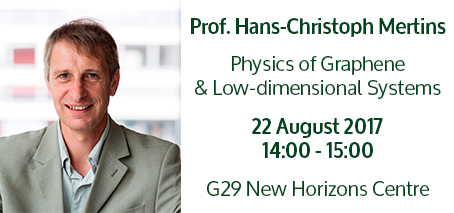-
FLEET Research Seminar: Hans-Christoph Mertins
22 Aug 2017
2:00 pm - 3:00 pm
Magneto-Optical Polarisation Spectroscopy with Synchrotron Radiation on Graphene
Seminar flyer can be downloaded here. All welcome.
Abstract: Polarisation spectroscopy with synchrotron radiation is a powerful tool for both, the investigation of structural and magnetic order in bulk material and two-dimensional systems. After giving an experimental review on polarisation detectors for synchrotron radiation the application to non-magnetic as well as to magneto-optical effects as Faraday, Kerr, Voigt and the X-Ray Circular Dichroism (XMCD) are presented [1, 2].
The existence of natural birefringence in x-ray reflection on graphene is demonstrated at energies spanning the carbon 1s absorption edge. This new x-ray effect has been discovered with precision measurements of the polarization-plane rotation and the polarization-ellipticity changes that occur upon reflection of linearly polarized synchrotron radiation on monolayer graphene. Extraordinarily large polarization-plane rotations of up to 30°, accompanied by a change from linearly to circularly polarized radiation have been measured for graphene [3].
The existence of a giant magneto-optical Faraday-effect at the carbon 1s edge of single-layer graphene on Co is demonstrated [4]. Exploiting resonant enhancement at the carbon 1s and at the cobalt 2p edges element-selective magnetic hysteresis curves can be monitored showing ferromagnetic order in graphene. The magnetism in graphene is found to be carried by and be strongly enhanced by aligned π-orbitals of carbon atoms that have a magnetic moment of 0.14mB deduced from XMCD and transversal magneto-optical Kerr effect (T-MOKE) spectra. The magnetism of graphene is induced by hybridization with the Co 3d orbitals where the position of carbon atoms of sublattice A or B plays a role. We show experimentally that the related reduction of A-B-symmetry leads to a splitting of the spin polarized density of conduction band states which is responsible for the strong magneto-optical Faraday effect.
About the Speaker: Prof. Hans-Christoph Mertins is a professor of physics at the University of Applied Sciences Muenster since 2003. Prior to this, he was a scientist at the large scale facility Berliner Elektronenspeicherring Gesellschaft für Synchrotronstrahlung mbH (BESSY) and working on the European Community TMR-LSF RTD Projects.
He was involved in the development of beamlines for synchrotron radiation and his research interests are on nano-structured multilayer systems and nano-materials for magnetic sensors, development and characterisation of X-ray mirrors and polarisation-detectors. Prof. Mertins also holds a patent for a polarization modulator for X-rays.
Visitors & parking at Monash Clayton Visitors are very welcome to attend seminars. A map of the Clayton campus can be found online. There are designated visitors car parks in the “N1” building (marked in blue, towards top left of the map) just west of the New Horizons Building. Visitor spaces are available on the ground floor (limited spaces, enter off Research Way gate 10) and top floor (level six, lots of spaces, enter via gate 2 off Innovation Walk). Tickets are $10/day or $2/hour, available from machines. More information.
References
[1] H.-Ch. Mertins et al., Appl. Phys. A 80, 1011 (2005) [2] H.-Ch. Mertins et al., Phys. Rev. Lett. 87, 047401 (2001). [3] C. Jansing et al., Phys. Rev. B 94, 045422 (2016). [4] H.-Ch. Mertins et al., J. Phys. Chem. Sol. (2017) in pressVenue: G29 New Horizons Centre, Monash University
Venue Website: https://www.monash.edu/engineering/our-research/facilities/new-horizons
Address:
